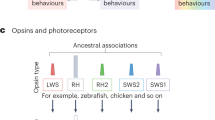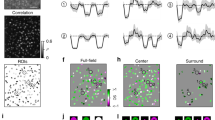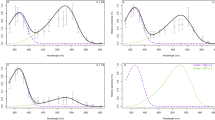Abstract
COLOUR vision in mammals has long been considered to be restricted to primates, possibly as a result of independent evolution of the ability after it was lost during a nocturnal stage of mammalian evolution1. A variety of investigations, however, have indicated some ability to discriminate on the basis of colour in the European red squirrel2, the pigmy goat, red deer, and Nilgai antelope3, the Masai giraffe4, the common cat5, and the antelope ground squirrel6. Because the Virginia opossum (Didelphis virginiana) is very similar to the earliest known mammals7, the presence or absence of colour vision in this species would be of particular relevance to theories of the phylogeny of colour vision in both marsupial and placental mammals. The marsupial eye is essentially like that of a placental mammal in structure, while the retina is basically a reptilian one containing single and double cones bearing oil-droplets and a large number of filament rods. In particular, the opossum has a clearly nocturnal eye and some of the single cones lack oil-droplets and are similar to the cones of placental mammals8. A further consideration is that the marsupials are the only class of vertebrates having double cones in the retina (fish, amphibians, reptiles, and birds being the others) which have not yet been shown to have colour vision9.
This is a preview of subscription content, access via your institution
Access options
Subscribe to this journal
Receive 51 print issues and online access
$199.00 per year
only $3.90 per issue
Buy this article
- Purchase on Springer Link
- Instant access to full article PDF
Prices may be subject to local taxes which are calculated during checkout
Similar content being viewed by others
References
Harlow, H., in Behavior and Evolution (edit. by Roe, A., and Simpson, G. G.) (Yale, New Haven, 1958); Walls, G. C., The Vertebrate Eye (Cranbrook, Bloomfield Hills, 1942).
Meyer-Oehme, D., Z. F. Tierpsychol., 14, 473 (1957).
Backhaus, D., Z. F. Tierpsychol., 16, 445 (1959).
Backhaus, D., Z. F. Tierpsychol., 16, 468 (1959).
Clayton, K., Amer. Psychol., 18, 407 (1963); Sechzer, J. A., and Brown, J. L., Science, 144, 427 (1964).
Crescitelli, F., and Pollack, J. D., Science, 150, 1316 (1965).
Young, J. Z., The Life of Vertebrates (Oxford, New York, 1962).
Walls, G. C., The Life of Vertebrates (Oxford, New York, 1962).
Svaetichin, G., Acta Physiol. Scand., 39, suppl. 134 (1956).
Friedman, H., Nature, 201, 323 (1964).
Friedman, H., and Marshall, D. A., Quart. J. Exp. Psychol., 17, 250 (1965).
Gellerman, L. W., J. Genet. Psychol., 42, 207 (1933).
Kohler, I., Sci. Amer., 206, 62 (1962).
Author information
Authors and Affiliations
Rights and permissions
About this article
Cite this article
FRIEDMAN, H. Colour Vision in the Virginia Opossum. Nature 213, 835–836 (1967). https://doi.org/10.1038/213835a0
Issue Date:
DOI: https://doi.org/10.1038/213835a0
This article is cited by
-
Cone pigments in a North American marsupial, the opossum (Didelphis virginiana)
Journal of Comparative Physiology A (2010)
Comments
By submitting a comment you agree to abide by our Terms and Community Guidelines. If you find something abusive or that does not comply with our terms or guidelines please flag it as inappropriate.



